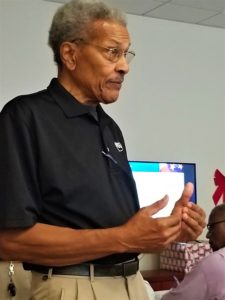
The U.S. Virgin Islands is no stranger to calamities, but it has never experienced anything quite like 1867 when three natural disasters bombarded the Danish West Indies, one after another within a month. They were a hurricane, an earthquake and a tsunami, rattling not only the islands but affecting events happening far from the Caribbean, a virtual audience learned on Saturday.
Roy Watlington, a retired University of the Virgin Islands professor and ocean research and development consultant, addressed about 100 people who logged on for the virtual presentation sponsored by the Caribbean Genealogy Library. He said he wanted to remind listeners “about the extreme events that the community has faced and survived and to see that natural hazards are always among the challenges communities face and to appreciate the need for a base level of scientific knowledge in our decision-makers.”
Watlington recalled his surprise when he learned of the tsunami that made landfall in the territory years ago.
“I had studied oceanography and was very familiar with tsunamis. But like many Virgin Islanders [I] did not know we had been visited by one,” Watlington said.
The trio of disasters occurred in the years just after the Civil War. The United States was still recovering from the conflict and the assassination of Abraham Lincoln. Reconstruction was underway and the U.S. had recently purchased Alaska from Russia and was beginning talks with Denmark for the acquisition of the Danish West Indies.
In October, Hurricane San Narciso made landfall in the Danish West Indies and caused between 500 and 600 casualties.
“It was coming in north of us, I believe something like what Hurricane Irma did in 2017,” Watlington said, “and then it jogged to the south just enough to make a westward trip right through the British Virgin Islands, St. John, St. Thomas and going on to Puerto Rico, sinking ships like the RMS Rhone and killing 150 people on board.”
During the two weeks after the hurricane, maritime activity continued in the territory. Coming into the territory were English, Danish and French ships carrying merchandise, and American ships carrying diplomats to resume meetings for the sale of the islands.
A month later, on Nov. 26, 1867, while the territory was still digging out from the hurricane, a massive earthquake impacted the islands. Earthquakes were not rated in 1867, Watlington said, but “the 1867 earthquake is estimated to have been of magnitude 7.3 to 7.5 on the Richter Scale.”
A temblor of that magnitude is considered a “major” earthquake, capable of causing damage to most buildings, and felt across great distances.
The 1867 quake took many lives, caused landslides, destroyed roads, buildings and infrastructure and caused aftershocks that occurred throughout the year and into 1868.
“Multiple earthquakes were followed for days and months afterward and people were afraid of sleeping inside of walled buildings,” Watlington said.
But the quake also brought something even more deadly and – for the Virgin Islands – more rare. The earthquake was followed by a tsunami.
“In six to ten minutes, the first waves of the tsunami followed the quake,” Watlington said. They hit Frederiksted first because “tsunamis travel faster in deep water and the water between the site of the earthquake and Frederiksted is very deep,” then Charlotte Amalie, Coral Bay and Christiansted.
He used a simulation to demonstrate the movement of the waves for viewers and spoke about Frederiksted as an example of the tsunami’s impact in the territory.
“The waves probably came into Frederiksted around 20 feet and it swept right through the town … the wave didn’t climb hills or topple major stone buildings, and that had some impact on the loss of life.”
Throughout the territory, the earthquake and tsunami only claimed the lives of about 24 to 30 people, Watlington said.
“Loss of life was moderate. Many people have a hard time with this. With such a tremendous disaster, people can’t believe as few as 24 may have lost their lives. I don’t find much verification for even much more than 24.”
But though life was mostly spared, the three disasters caused much damage throughout the islands. Goods, vessels, warehouses, shops and coal stocks were destroyed. Commerce was disrupted for months, affecting the value of Charlotte Amalie and its harbor. The land and sea were contaminated with sewage, oils, dead animals and infectious diseases such as yellow fever claimed more lives.
When asked if the outcome of the disasters affected the transfer of the Danish West Indies to become the Virgin Islands of the United States, Watlington said, “It seems that it did but was one of the least significant factors. U.S. internal political struggles in the reconstruction mattered more as did circumstances and timing. It was unfortunate to be occurring right after ‘Seward’s Folly’ [after Secretary of State William Seward, who negotiated the deal with Russia] and when strong support and management could no longer be counted on from the White House.”
The transfer of the Danish West Indies to the United States took another half-century and another war – the First World War – before it could be brought about.
In 1997, Watlington and longtime Enid Baa librarian Shirley Lincoln published “Disaster and Disruption in 1867: Hurricane, Earthquake and Tsunami in the Danish West Indies.” The book includes accounts and reports of the disasters that occurred in 1867.


